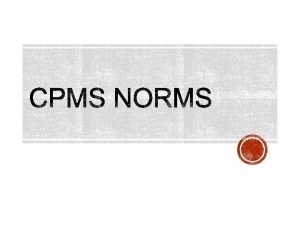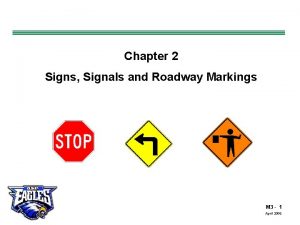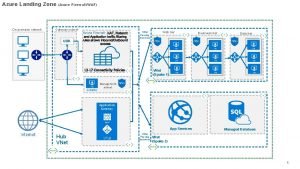Regulatory Considerations Character is doing the right thing






















- Slides: 22

Regulatory Considerations

Character is doing the right thing when no one is looking. —J. C. Watts

Course Layout: M&A & Other Restructuring Activities Part I: M&A Environment Part II: M&A Process Part III: M&A Valuation & Modeling Part IV: Deal Structuring & Financing Part V: Alternative Strategies Motivations for M&A Business & Acquisition Plans Public Company Valuation Payment & Legal Considerations Business Alliances Regulatory Considerations Search through Closing Activities Private Company Valuation Accounting & Tax Considerations Divestitures, Spin-Offs & Carve-Outs Takeover Tactics and Defenses M&A Integration Financial Modeling Techniques Financing Strategies Bankruptcy & Liquidation Cross-Border Transactions

Current Chapter Learning Objectives • Primary objective: To enable students to understand the key elements of selected federal and state regulations applicable to M&A • Secondary objective: Provide students with an understanding of – Pre-notification and disclosure requirements of current security and antitrust legislation – How decisions are made in security and antitrust enforcement agencies – How environmental, labor and benefit laws affect M&As – Key elements of the Sarbanes-Oxley legislation

Federal Securities Laws • Securities Act (1933) • Requires registration of publicly offered securities • Securities Exchange Act (1934) • Empowers SEC to revoke registration – Section 13 – Defines content & frequency of SEC filings – Section 14 – Defines proxy disclosure requirements • Williams Act (1968) – Section 13 D • Regulates tender offers – Defines disclosure requirements

Summary of Regulatory Pre-Notification Filing Requirements • Williams Act – Schedule 13 D must be filled with the SEC within 10 days of acquiring 5% of stock in another firm. – Schedule 14 D-1 must be filed with the SEC for tender offers – Tender offers must stay open a minimum of 20 business days • Hart-Scott-Rodino Act – Filing necessary with FTC when buyer purchases assets or securities >$63. 4 million or buyer or seller has annual sales or assets ≥ $126. 9 million and other party has sales or assets ≥ $12. 7 million. These thresholds increased annually by change in GDP implicit price deflator – 30 day waiting period before transaction can be completed

Federal Antitrust Laws • Sherman Act (1890) – Section 1 – Section 2 • Clayton Act (1914) • Celler-Kefauver Act (1914) • Hart Scott Rodino Antitrust Improvement Act (1976) • Establishes criminal penalties for restraint of trade – Makes mergers creating monopolies illegal – Applies to firms already dominant in served markets • Created FTC • Amended Clayton Act to include asset as well as stock purchases • Requires waiting period before transaction can be completed

Discussion Questions 1. 2. 3. What is the purpose of pre-notification and disclosure requirements of current security and antitrust legislation? Be specific. How might such requirements affect the size of purchase price premiums paid to target firms? Be specific. Based on your answer to question 2, what is the potential impact on abnormal returns to acquiring company shareholders?

State M&A Laws • Anti-takeover Laws • Antitrust Laws • Define conditions under which a change in corporate ownership can take place. • Similar to federal laws – States may sue to block mergers even if not challenged by federal regulators

Other Applicable Legislation • Environmental laws (federal and state) • Banking, communications, railroads, defense, insurance, and public utilities • Define disclosure requirements • Labor and benefit laws (federal and state) • Define disclosure requirements • Applicable foreign laws • Cross-border transactions subject to laws of countries in which participants have operations • Industry specific laws

Navigating Antitrust Laws (Horizontal Mergers) • Step 1: Define market and determine concentration. – Herfindahl-Hirschman Index • Step 2: Determine potential adverse competitive effects of mergers. – Coordinated interaction – Differentiated products – Similarity of substitutes • Step 3: Identify entry barriers. – Proprietary technology, patents, government regulations, investment requirements, or exclusive ownership of natural resources. • Step 4: Identify potential efficiencies resulting from business combinations. • Step 5: Assess continued viability of firm without merger.

Navigating Antitrust Laws (Vertical Mergers) • Steps described for horizontal mergers also apply to vertical mergers • Regulators unlikely to challenge vertical mergers unless – Relevant market highly concentrated – Merger limits access by others to a key supplier

Navigating Antitrust Laws (Collaborative Efforts) • Alliances and JVs do not generally require approval of regulatory authorities if – The combined strength of partners does not result in a dominant market share in the global market for the product or service – Smaller companies not holding dominant market shares are unaffected – Access to key resources by competitors is not restricted – Pricing practices or customer allocation among partners does not unreasonably restrict trade

State Anti-takeover Laws • Fair price provisions require that all target shareholders receive the same price when tender shares • Business combination provisions preclude sale of assets for a specific period following buyout, thereby inhibiting financing of purchase price • Cash-out provisions require acquirers purchasing more than a stipulated amount of target stock to offer to purchase 100% of remaining stock at same price. • Share control provisions require acquirers whose purchases exceed some threshold to get approval of shareholders owning large blocks of target stock before proceeding with merger

State Antitrust Laws • States granted increased antitrust power as part of Hart-Scott-Rodino Act of 1976 • Powers often similar to federal laws • States have right to sue to block mergers they consider anti-competitive, even if the Do. J or FTC do not challenge them

Sarbanes-Oxley Bill (7/31/02) • Created Public Company Accounting Oversight Board whose responsibilities include: --Registering public accounting firms --Establishing auditing standards --Establishing code of conduct • Prohibits accounting firms from offering certain nonauditing services (e. g. , information technology) • Requires audit committees to consist of independent directors • Requires CEOs/CFOs to certify financial statements • Provides for disclosure of all material off-balance sheet transactions • Increases criminal penalties to include prison sentence of up to 20 years

Dodd-Frank Act of 2010: Governance & Executive Compensation • Say on Pay: In a nonbinding vote, shareholders may vote on executive pay every 3 yrs. • Say on Golden Parachutes (executive severance packages): Proxy statements seeking shareholder approval of M&As or sale of most of a firm’s assets must disclose pay agreements with target or acquirer executives • Clawbacks: Public firms must disclose mechanisms for recovering incentive pay paid during 3 -yrs prior to earnings restatements. • Proxy Access: SEC has authority to require public firms to include nominees submitted by shareholders in proxy materials • Broker Discretionary Voting: Stock exchanges must prohibit brokers from voting shares without direction from owners in election of directors and executive compensation

Dodd-Frank Act of 2010: Systemic Regulation and Emergency Powers • Financial Stability Oversight Council (FSOC): Monitors U. S. financial markets to identify banks and nonbanks exhibiting “systemic” risk. • New Fed Bank/Nonbank Supervisory Powers: Banks/nonbanks with total assets ≥ $50 billion must – Submit plans for their rapid dissolution in event of failure – Limit their credit exposure in any unaffiliated firm to 25% of its capital – Conduct semiannual stress tests to determine capital adequacy – Provide advance notice of intent to buy voting shares in financial firms • Leverage Limitations: Fed may require banks with assets ≥ $50 billion to maintain debt-to-equity ratio of no more than 15 to 1. • Size Limitations: No bank or nonbank can hold deposits > 10% of deposits nationwide; does not apply to mergers involving failing banks. • FDIC Guaranty Powers: May guaranty liabilities of solvent banks if FSOC and Fed determine appropriate to do so. • Orderly Liquidation Authority: FDIC may seize and liquidate banks threatening U. S. financial stability • New Bank Capital Requirements: At discretion of regulators.

Dodd-Frank Act of 2010: Capital Markets • Office of Credit Ratings: Sets rules for transparency, conducts audits and makes it easier to sue rating agencies. • Securitization: Issuers of asset-backed securities must retain an interest of at least 5% of any security sold to third parties. • Hedge and Private Equity Fund Registration: Must register with SEC as investment advisors if assets ≥ $100; those with < $100 million subject to state regulation. • Clearing and Trading of OTC Derivatives: Must be traded on formal exchanges to provide real time data reporting to market participants.

Dodd-Frank Act of 2010: Financial Institutions • Volcker Rule: Prohibits insured banks from buying and selling securities with their own money (i. e. , proprietary trading) or sponsoring or investing in hedge funds or private equity funds; banks may do so if they have no control over funds. • Consumer Financial Protection Bureau: Writes rules governing financial institutions offering consumer financial products • Federal Insurance Office: Monitors insurance industry and recommends which firms should be considered systemically important.

Discussion Questions 1. Do you believe that current M&A regulations are sufficient to minimize abuse? Explain your answer. 2. Are there other ways in which you believe that M&As should be regulated? Be specific. 3. Do you see areas of potential conflict between federal and state antitrust laws? Be specific. 4. How do you believe the Sarbanes-Oxley Act will impact the number of initial public offerings and the number of firms converting from public to private status? Explain your answer.

Things to Remember • Securities Acts of 1933 and 1934 established the SEC and require that all securities offered to the public must be registered with the government. • Williams Act requires those acquiring 5% or more of another firm to file a Schedule 13 D disclosing their ultimate intentions – Firms initiating tender offers must disclose their intentions and business plans in a Schedule 14 D-1. • Sherman and Clayton Acts make illegal agreements to fix prices, allocate customers among competitors, or to merge with another firm if it reduces competition • Hart-Scott-Rodino Act requires that mergers exceeding a certain size must notify the FTC and Do. J at the time it makes an offer to the target. • Antitrust regulators determine whether to challenge a merger by an analysis of market concentration, potential for price fixing, ease of entry, impact on innovation, potential for improved efficiency, and the likelihood the target firm will fail on its own.
 Right product right place right time right price
Right product right place right time right price Family time
Family time Integrity is doing the right thing when nobody's watching
Integrity is doing the right thing when nobody's watching Lately ive been ive been losing sleep
Lately ive been ive been losing sleep The right man on the right place at the right time
The right man on the right place at the right time Anything worth doing is not necessarily worth doing well
Anything worth doing is not necessarily worth doing well Doing nothing is doing ill
Doing nothing is doing ill Fluorescent optic yellow road sign
Fluorescent optic yellow road sign There is no wrong way to do the right thing
There is no wrong way to do the right thing A symbol is
A symbol is Unt kanopy
Unt kanopy Nexposture
Nexposture When a character says one thing but means the opposite.
When a character says one thing but means the opposite. Tax considerations for setting up a new business
Tax considerations for setting up a new business Sample of ethical consideration in research
Sample of ethical consideration in research Antecubial region
Antecubial region Compare and contrast first and second language acquisition
Compare and contrast first and second language acquisition Web security considerations
Web security considerations Ethical issues in experimental research
Ethical issues in experimental research Bioreactor considerations for animal cell culture
Bioreactor considerations for animal cell culture Three considerations of societal marketing concept
Three considerations of societal marketing concept Example of ethical consideration in research
Example of ethical consideration in research Azure landing zone hub and spoke
Azure landing zone hub and spoke










































